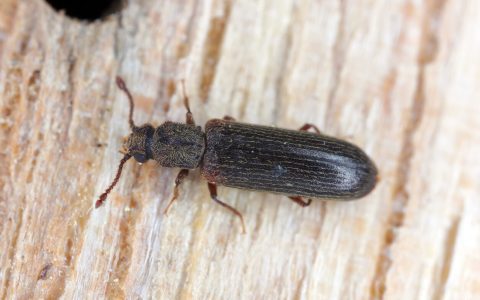Discovering small black bugs in your kitchen can be unsettling. Identifying the pest is the first step towards effective control. Several common culprits fit this description, each with preferred habitats and food sources.
Common Culprits and Identification
- Pantry Pests (e.g., Grain Beetles, Flour Beetles, Weevils): These are among the most common. They are typically very small, dark brown to black, and are found in or near stored food products. Check flour, cereals, pasta, spices, dried fruits, and pet food. Weevils often have a noticeable snout.
- Ants (e.g., Little Black Ants): Small, black ants may forage in kitchens for crumbs, spills, or water. You'll usually see them traveling in trails.
- Fruit Flies: While often brownish, some can appear dark, especially from a distance. They are tiny, hover around ripe or fermenting fruits, vegetables, drains, and garbage disposals.
- Drain Flies (Moth Flies): These are small, dark, fuzzy-looking flies with rounded wings. They breed in the organic slime found in drains, so they are often seen near sinks or floor drains.
- Cockroach Nymphs: Immature stages of some cockroach species can be small and dark. They prefer dark, moist areas and are typically nocturnal.
- Fungus Gnats: Small, dark, delicate flies often associated with overwatered houseplants or moist organic debris. They might wander into the kitchen if plants are nearby.
Primary Causes of Infestation
- Available Food Sources: Spilled crumbs, unsealed food packages (especially grains, flour, sugar), and overripe produce attract pests.
- Moisture: Leaky pipes, damp sponges, standing water in sinks or under appliances, and condensation provide necessary moisture for many pests.
- Entry Points: Bugs can enter through cracks and crevices in walls, foundations, around windows, doors, and utility lines. They can also be brought in on infested grocery items.
- Poor Sanitation: Infrequent cleaning, full trash cans, and dirty drains create ideal breeding and feeding grounds.
Prevention Strategies
- Proper Food Storage: Store all dry goods (flour, grains, cereals, pasta, pet food) in airtight containers made of glass or hard plastic. Inspect new groceries before storing.
- Maintain Cleanliness: Wipe up spills and crumbs immediately. Regularly clean countertops, shelves, floors (especially under appliances), and pantries. Empty trash cans frequently and ensure they have tight-fitting lids.
- Control Moisture: Fix leaky faucets and pipes promptly. Ensure drains are clean and free-flowing. Avoid overwatering houseplants. Ventilate damp areas if possible.
- Seal Entry Points: Inspect and seal any cracks, crevices, or gaps around windows, doors, pipes, and foundations using caulk. Ensure window and door screens are in good repair.
- Regular Inspections: Periodically check pantry shelves, food packages, and areas prone to moisture for any signs of pest activity.
Elimination Methods
- Identify the Pest: Accurate identification helps in choosing the most effective control method. Observe where the bugs are most prevalent and what they seem attracted to.
- Thorough Cleaning and Discarding:
- Empty affected cupboards and pantries. Vacuum shelves thoroughly, paying attention to corners and crevices.
- Inspect all food items. Discard any infested products in a sealed bag outside the home.
- Wipe down shelves with warm, soapy water or a diluted vinegar solution.
- Targeted Treatments:
- For Pantry Pests: After cleaning, ensure all new food is stored in airtight containers. Bay leaves placed on shelves or in containers can act as a mild repellent for some pantry pests.
- For Ants: Use ant baits (liquid or gel) placed near trails but out of reach of children and pets. Clean ant trails with soapy water or a vinegar solution to remove pheromones.
- For Fruit Flies: Remove their breeding sources (overripe fruit, spills, dirty drains). Create traps using apple cider vinegar with a drop of dish soap in a small jar.
- For Drain Flies: Clean drains thoroughly using a stiff brush and an enzymatic drain cleaner or by carefully pouring boiling water down the drain (use caution with PVC pipes).
- Professional Assistance: If the infestation is widespread, persistent, or you are unsure of the pest, consider contacting a licensed pest control professional for effective and safe extermination.
By implementing these preventative measures and targeted elimination strategies, you can effectively manage and remove small black bugs from your kitchen.










